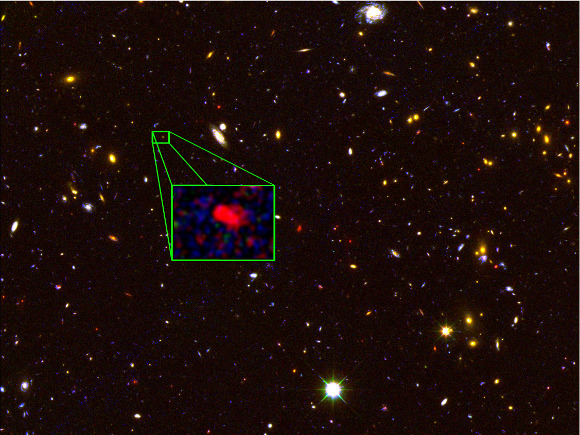“The farthest galaxy yet seen!” Haven’t we heard that one before? (See here and here, for example.) While it’s true that astronomers keep pushing farther back in time with better instruments, there are fundamental challenges both in observing and measuring the distances to the earliest galaxies in the cosmos.
That’s why this new observation of a galaxy that formed about 700 million years after the Big Bang is significant. While scores of galaxies have been identified that formed in that era, astronomers have only measured accurate distances for five of them. This galaxy marks the sixth, and it is the farthest of the bunch. Perhaps even more important than the distance measurement, researchers determined that this galaxy gave birth to new stars at more than 100 times the rate the Milky Way does today. That indicates early galaxies may have been more aggressive with star-formation than previously believed.
A new paper published in Nature (paywall warning) describes the measurement of the redshift of a galaxy identified in the Cosmic Assembly Near-infrared Deep Extragalactic Legacy Survey (CANDELS), which uses the infrared spectrograph on the Keck telescope in Hawaii. Because of this vast distance, the Hubble Space Telescope doesn’t see the galaxy in its optical bands, but it is a bright source in infrared, both for Hubble and the Spitzer Space Telescope. Redshift, if you recall, is a measure of how quickly a galaxy appears to be moving away from us as the Universe expands; the higher the redshift, the farther away that galaxy is — and therefore the longer ago it emitted the light we see. As the Universe grows, it stretches the wavelength of light proportionally. In that way, the visible light or even ultraviolet emission common in stars is redshifted into the infrared portion of the spectrum.
In this case, astronomers measured the redshift of galaxy z8_GND_5296 (there’s a memorable name for you) to be 7.51, which translates to approximately 13 billion light-years away. They determined this number by measuring Lyman alpha (Ly α ) emission from hydrogen gas, which is both very common and difficult to measure at such large distances. Ly α light from hydrogen gas at our location is about 122 nanometers, firmly in the ultraviolet portion of the spectrum, but the corresponding emission from z8_GND_5296 is about 1034 nanometers, which is infrared. (To get the redshift, divide the bigger number by the smaller and subtract 1. Unfortunately, the relationship between redshift and distance is nowhere as simple.)
However, not every galaxy at comparable distances has measurable Ly α emissions: something appears to be preventing much of that light from reaching us. The leading idea is neutral intergalactic gas scattering the light, but there are too few galaxies observed to confirm that hypothesis. As a result, while there are dozens of galaxies with redshifts greater than 7 (determined not by spectrum but by the apparent color of the galaxy), the redshifts cannot be double-checked for most. This paper reports on 43 early galaxies, but only one of that sample had measurable Ly α emissions.
More interestingly, galaxy z8_GND_5296 is relatively rich in “metals”: elements heavier than helium. Since these elements are produced by stars rather than the Big Bang, that indicates a very rapid cycle of star birth and death even by the time this galaxy emitted the light we observe.
To support that assertion, the authors of the present study found that z8_GND_5296 and a similar galaxy designated GN 108036 have extremely high star formation rates, converting the equivalent of 330 Suns worth of mass into new stars. That’s more than 100 times the star formation rate of the Milky Way, and comparable to some of the most extreme star-forming galaxies. These galaxies were previously thought to be rare, so astronomers may need to revise their estimates on how rapidly new stars were made in early galaxies.
No matter what, it will be interesting to see what other early galaxies are like as our observations improve. Without that, we won’t know if z8_GND_5296 is a rarity in its extreme star formation, or understand why it is relatively bright in Ly α emissions while its siblings are not. And maybe we’ll find the division in time between the era with no galaxies and the very first galaxies to form.

